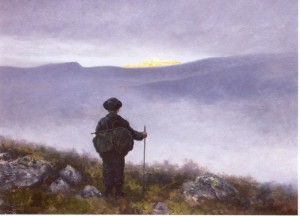Finding your own story
Finding a story you believe in, is a work in itself. It can be, and perhaps should be, demanding. Sometimes it’s like searching for the impossible ‘Soria Moria Castle’! Remembering tales you heard as a child, scouring bookshops, talking to people, researching in libraries, visiting galleries, travelling, are all ways of finding a story. Librarian Eileen Colwell was a pioneer storyteller who understood the value of storytelling and instigated the telling of tales in UK libraries from 1930 right up to her death, aged 98, in 2002. Her beautiful, simple book Storytelling (1980) describes the essential skills of how to tell stories. Her advice on how to choose a story is spot-on:
“It is impossible to say what makes one particular story yours, but I have found that suddenly a story leaps from the page and is alive and full of meaning for me. I know that it is my story and that I shall be able to tell it with conviction.”
For many of us, finding an oral story is a paradox. Our first encounter with a fairytale is probably within the pages of a book. Most traditional tales have undergone many transformations: told in a market place; carried across the world by traders; gathered by writers; made into films and operas, often coming full-circle and returning to a performance on a street corner. But once you have found the precious tale that leaps out at you, the work of bringing it back to a life on the tongue can begin.

Finding your heritage of stories
Lists: Take a large sheet of paper and make a list of all the stories you loved as a child, teenager, adult. Note down those half-remembered, half-forgotten tales. It doesn’t matter if you can’t remember a title, write down the image you remember from the tale. Your list might include films and books, tales of family events, stories made up by a relation or neighbour, stories you heard in your mother tongue, stories you heard in other languages.
Links: Using a different coloured pen, mark the stories you feel a close connection with. These tales might have images that jump vividly into your mind, or have situations or characters you like. Perhaps these stories have an emotional resonance or meaning?
Origins: Think about the origins of the stories on your list. Look at each title and see if you can discern its origin. See if you can distinguish the stories on your list that have an oral origin. Think about whether the story has a named author. Or perhaps versions of the tale can be found in many parts of the world? Perhaps the story was once collected by someone – such as the Brother’s Grimm in Germany (1812), Asbjornsen and Moe in Norway (1845), Aleksandr Afanas’ev in Russia (1855). Using another coloured pen, mark the stories that you think have an oral origin, particularly the ones you might have heard yourself.
Heritage: Look at your list, this is your heritage of stories. Some told, some written, some seen, some heard. Which one will you tell?

BB
Nice post
Sally Pomme
thank you